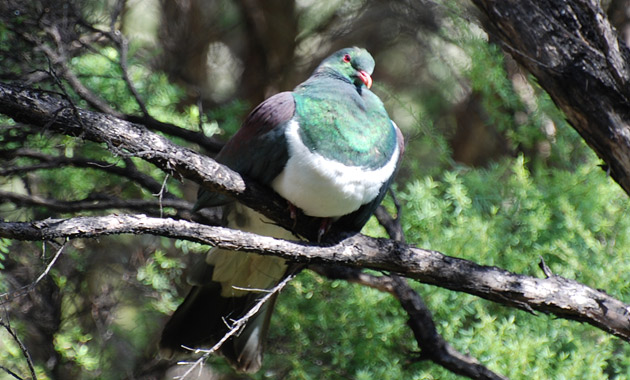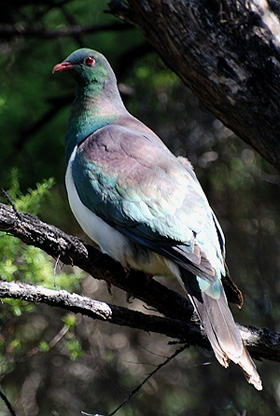|
|
| |
 |
| |
| |
NEW ZEALAND ECOLOGY |
|
| |
|
|
|
|
FRUIT - EATING BIRDS |
|
| |
|
| |
| |
The kereru Hemiphaga novaeseelandiae, also known as the New Zealand pigeon and kukupa to Northern Maori, belongs to the successful and widespread Columbidae family of pigeons and doves, of the Columbiformes order.
The genus Hemiphaga, now containing only two species is endemic to New Zealand. The Norfolk Island pigeon Hemiphaga novaeseelandiae spadicea became extinct in the early 20th century.
H. novaeseelandiae is now only found on the New Zealand mainland and offshore islands, and the other species of the genus, the parea Hemiphaga chathamensis, is only found on the main island of the Chatham Islands. |
| |
 |
| |
Above: Kereru Hemiphaga novaeseelandiae at Whakanewha Regional Park, Rocky Bay, Waiheke Island. This bird appeared to fly into the perch to visit the photographer, stayed for 15 minutes, and seemed aware of what was going on, posing front and back. Photo Copyright © 2010 Graeme Woodhouse.
 View slideshow of larger images View slideshow of larger images |
| |
 |
| |
Together with tui and fantail, kereru are the most resilient, and most commonly found forest bird in native lowland forests throughout New Zealand, even though it is in decline. It particularly favours podocarp/broadleaf forests.
Kereru Hemiphaga novaeseelandiae is listed in the threatened category of 'gradual decline' in the New Zealand Threat Classification System, while its Chatham Island relative, parea Hemiphaga chathamensis is endangered with a listing of 'nationally critical'.
Kereru was upgraded in 2007 from 'least concern' to 'near threatened', and parea is 'endangered' in the 2008 IUCN Red List of Threatened Species.
The mainland kereru grow to about 51 cm tall and 650 grams in weight. Larger Chatham Island parea reach 55 cm and 800 grams.
Kereru nest in the spring or early summer. Their mating involves a most spectacular aerobatic performance by both male and female. Flapping their powerful wings, they rise vertically from a perch to a stall, and then dive into loops.
Only one long and narrow white egg is laid, brooded by both parents in shifts during a four-week period of incubation. Kereru are slow to breed, and are long-lived, but in modern times less than 15 per cent of chicks survive to maturity.
Doves and pigeons initially feed their chicks crop milk, which is a cheese like secretion rich in protein. Regurgitated food becomes a larger part of the diet as the chick matures. Emperor penguins and flamingoes are the only other birds that produce food for their chicks.
Kereru is a quiet bird. A soft “coo” is sometimes heard, but their presence in the forest is mostly detected by the strong whooshing sound of their wings in flight.
They take a shower in rain, covering all body parts and pure white breast, by hanging upside down on their perch.
Pigeons can drink by suction, unlike the majority of birds, swallowing without raising their heads. |
| |
 |
| |
|
|
|
A kereru Hemiphaga novaeseelandiae perching in kanuka Leptospermum ericoides at Whakanewha Regional Park, Rocky Bay, Waiheke Island.
Photo Copyright © 2010 Graeme Woodhouse.
 Hear the sound of New Zealand pigeon/kereru with its strong wingbeat MP3 1,868K 1 min 58 sec. Hear the sound of New Zealand pigeon/kereru with its strong wingbeat MP3 1,868K 1 min 58 sec.
Crown Copyright © Department of Conservation
|
| |
 |
| |
The most important seed disperser of native plants ......
About 70 percent of the woody plants in New Zealand forests have fruits suited for vertebrate dispersal and, of these, most are probably dispersed by birds [Clout & Hay 1989]. Tree species are 33 percent of the flora, compared to a mean 9 percent for temperate flora worldwide.
About 70 percent of New Zealand's forest bird species, including most small insectivores, eat fruits. Most New Zealand fruits are clearly adapted for bird dispersal. [Buller 1888; Clout & Hay 1989].
Across 32 studied species of native fleshy-fruited plants, the majority (84 percent) of fruit dispersal was by four birds - kereru, tui, bellbirds and silvereyes - although another 11 native and 7 introduced bird species took small quantities of fruit [Kelly et al. 2006]. |
| |
 |
| |
Kereru is the most consumptive fruit-eating bird providing an essential function in lowland forest ecological sustainability and restoration by dispersing seeds. |
| |
 |
| |
|
New Zealand pigeon play an important seed dispersal role, consuming fruits of at least 70 plant species and defecating the seeds intact [McEwen 1978; Clout & Hay 1989; Kelly et al. 2006].
Recent extinction of several frugivorous forest birds (e.g., moas, piopio Turnagra capensis, huia Heterolocha acutirostris) and the decline of others (e.g., kokako) has reduced the number of potential seed dispersers, especially for large-fruited species, some of which now depend almost entirely on kereru for seed dispersal. [Clout & Hay 1989]
The kereru's gape, which is the width of the outside of the bill at the base of the upper mandible, is an average of 14 mm. However its' gape is distensible, allowing it to swell up from inside, swallowing whole fruit up to 25 mm in diameter.
Kereru were previously thought to be the only disperser of the large 19.6mm diameter fruit of taraire Beilschmiedia tarairi, but kokako have more recently been seen eating the fruit. Kereru remain the only reliable disperser because of the very limited range of kokako.
Other large fruit in the range of 15 to 19 mm diameter are provided by tawapou Planchonella costata (18.3mm), karaka corynocarpus laevigatus (17.5mm), tawa Beilschmiedia tawa (15.5mm), and puriri Vitex lucens (15.3mm).
Smaller tree fruit eaten by kereru in the range of 10 to 13 mm diameter include swamp maire Syzygium maire (13.1mm), titoki Alectryon excelsus (13.0mm), and mangeao Litsea calicaris (12.5mm).
The smallest tree fruit around 9 mm diameter are provided by pigeonwood Hedycarya arborea (9.7mm), black maire Nestegis cunninghamii (9.6mm), hinau Elaeocarpus dentatus (9.2mm), nikau Rhopalostylis sapida (9.1mm), and kohekohe Dysoxylum spectabile (9.0mm).
During a good fruiting season podocarp seed is effectively dispersed in Pureora Forest by pigeons, tuis, and bellbirds, sometimes in local concentrations [Beveridge 1967]. These large podocarps include rimu Dacrydium cupressinum, totara Podocarpus totara, kahikatea Dacrycarpus dacrydioides, miro Prumnopitys ferruginea (13.0mm diam), and matai P. taxifolia (9.4mm).
Pigeon droppings may consist entirely of podocarp seed plus fibrous parts of the fruit. Large droppings attributed to pigeons have contained up to 100 kahikatea seeds or twelve matai seeds [Beveridge 1967].
A whole range of smaller trees, shrubs and vines are also sources of fruit, including supplejack vine, mahoe, and various Coprosma and Pseudopanax species.
Its' diet is supplemented with tree leaves and occasionally small twigs during late winter, spring and early summer when fruit is not available, sometimes causing severe defoliation. Kereru have been observed eating the leaves of 41 species of native plants and over 20 introduced species (McEwen, 1978, pers. obs.).
Native plants regularly browsed include Sophora spp., Parsonsia and Coprosma spp., Paratrophis microphylla, Melicytus micranthus, Hoheria spp. and Plagianthus regius.
Other folivorous birds in New Zealand forests include 11 species of extinct moa, kokako, kakapo, and red and yellow-crowned parakeet. |
| |
 |
| |
|
|
A long history of human consumption of kereru
Restrictions on shooting pigeon were first enacted in 1864, and total protection has been in place since 1921. There have been recent prosecutions for shooting pigeon, which presently has total protection under the Wildlife Act 1953.
Nevertheless, protective legislation did not stop human consumption of pigeon, the largest of the flighted forest birds which get plump and sumptuous when food is available. Some Maori make the claim that killing pigeon for food is a traditional right.
Illegal hunting is predominant in Northland where kereru are in rapid decline. A 1993 survey showed a 50 percent decline in 14 years.
Maori noticed that pigeon get thirsty after eating berries, so nooses around drinking troughs were used in hunting. In more modern times this method has been replaced by the gun.
As primarily frugivorous, kereru must eat large quantities of fruit to obtain sufficient nutrition. They gorge on a large variety of native fruit as it is in season, and during a particular fruiting period, their flesh takes on the taste of that fruit.
In A history of the birds of New Zealand, published in 1888, Sir Walter Buller wrote "in the spring and early summer it is generally very lean and unfit for the table; but as autumn advances and its favourite berries ripen, it rapidly improves in condition, till it becomes extremely fat.
It is esteemed most by epicures when feeding on the mast of the miro, which imparts a peculiar richness to the flesh.
| |
 |
| |
Kereru were speared and snared in great numbers by Maori, sometimes taking as many as sixty in one day. |
| |
 |
| |
In January the berries of the kohutuhutu, poroporo, kaiwiria, puriri, mangiao, and tupakihi constitute its ordinary bill of fare. From February to April their place is supplied by those of the tawa, matai, kahikatea, mapau, titoki, and maire.
It is worth remarking that in localities where it happens to be feeding exclusively on the pulpy fruit of the kahikatea, it is not only in very poor condition, but acquires a disagreeable flavour from the turpentine contained in the seeds.
Towards the close of this period also, the ti-palm, which comes into full bearing only at intervals of three or four years, occasionally supplies this bird with an abundant feast. These tropical-looking palms often form extensive groves in the open country or in swampy situations; and when the pigeons resort to them they are speared and snared in great numbers by the Maoris, an expert hand sometimes taking as many as sixty in a single day.
In May and June it feeds chiefly on the miro and pate, when it reaches its prime and is much sought after. From July to September it lives almost entirely on taraire in the north, and on hinau, koeka, ramarama, and other smaller berries in the south.
During the months of October, November, and December it is compelled to subsist in a great measure upon the green leaves of the kowhai Sophora tetraptera, whauhi, and of several creeping plants. It also feeds on the tender shoots of the puwha, a kind of sow-thistle; and the flesh then partakes of the bitterness of that plant.
When the bird is feeding wholly on the dark berries of the whao the colour of its flesh is said to become affected by that of the food."
References
Beveridge AE, Dispersal and destruction of seed in Central North Island podocarp forests, Forest Research Institute, Rotorua, Proceedings of the New Zealand Ecological Society 11: 48-55, 1964.
Buller WL, A History of the birds of New Zealand, Sir Walter Lawry Buller, London 1888, The New Zealand Electronic Text Centre (Creative Commons Attribution-Share Alike 3.0 New Zealand Licence).
Clout MN, Hay JR, The importance of birds as browsers, pollinators and seed dispersers in New Zealand forests, New Zealand Journal of Ecology, Vol 12 (supplement) 1989.
Kelly D, Ladley JJ, Robertson AW, Anderson SH, Wotton DM, Wiser SK, Mutalisms with the wreckage of an avifauna: The status of bird pollination and fruit-dispersal in New Zealand, New Zealand Journal of Ecology, (2010) 34(1): pp 66-85.
|
| |
 |
| |
|

